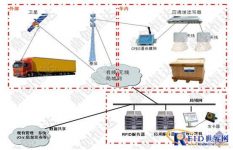
Dingchuang Hengda RFID cargo transportation anti-theft management system solution
[ad_1]
System background
Among the top ten logistics companies in the world, there are five American companies, and the sum of the income of these five companies accounts for 2/3 of the top ten companies’ income. Among these companies, most of them are transportation-based companies. The National Cargo Security Association (NC-SC) recently completed a survey that pointed out that US$15 billion worth of goods are stolen every year in supply chain management in the United States, accounting for one-third of the total global stolen goods, becoming stolen. The area with the worst cargo. Faced with such a serious phenomenon of theft of goods, most insurance companies in the United States have recently provided logistics companies with a rapid increase in insurance premiums related to theft of goods in warehouses, trucks, and storage yards, and implemented measures of “deductible”, such as the total value of stolen goods If the amount is less than 100,000 U.S. dollars, the logistics company must bear the full amount. Generally, the losses in theft cases are below this amount. American aviation and logistics expert Garfinkle believes that most small-lot theft cases are committed by acquaintances or company insiders. The security systems of many logistics companies are inefficient and loose, especially in the transportation of goods, which is the easiest link for company employees to steal goods.
It can be seen that the problem of anti-theft of goods has become an urgent problem that logistics companies need to solve in logistics transportation. Based on the simultaneous application of RFID technology and 3G technology, Beijing Dingchuang Hengda Intelligent Technology Co., Ltd. has studied the comprehensive application of these two technologies in the transportation of goods, which can effectively solve the problem of anti-theft of goods during transportation.
Technology Introduction
Radio Frequency Identification (RFID) is a non-contact automatic identification technology that automatically identifies target objects and obtains relevant data through radio frequency signals. Generally, an RFID system is composed of three main parts: an electronic tag, a reader and a data management system: An electronic tag is composed of an antenna and an RFID chip, and each chip contains a unique identification code to indicate the object attached to the electronic tag ; The reader is used to read and write the information in the electronic tag. The reader communicates with other computers or systems through the network to complete the information acquisition, interpretation and data management of the electronic tag; the data management system mainly completes the storage and management of data information , The data management system can be a simple small database or a large ERP database management software integrated with an RFID management module.
Its working principle: After the tag enters the magnetic field, it receives the radio frequency signal sent by the reader, and uses the energy obtained by the induced current to send out the product information stored in the chip (Passive Tag, passive tag or passive tag), or actively send some A frequency signal (Active Tag, active tag or active tag), the reader reads and decodes the information, and then sends it to the data management system for relevant information processing.
“3G technology” does not simply refer to the three separate technologies of GIS, GPS, and GSM, but the collective name of the three technologies represented by GIS technology, positioning technology, and wireless communication technology and the new technologies generated by their mutual integration . The core of 3G technology integration lies in: GIS can be used as a basic information system platform, with the advantages of visualization, geographic analysis and spatial analysis, unified database management, etc.; GPS positioning technology and navigation technology can obtain different accuracy in real time according to specific application needs. Target location information; GSM communication technology can realize large-scale data transmission, which is of great significance for information system command, dispatch, monitoring, and management. The integration of these three technologies can effectively realize the real-time dynamic tracking and monitoring of transportation vehicles.
System composition

Software Environment
Serial number name:
1 Operating system: Windows XP/NT/2000/2003
2 Database: SQL Server 2005
3 Development language: c#
4 Development environment: Microsoft Visual Stdio.Net 2008
5 Architecture: Combination of C/S and B/S
Hardware inventory
Serial number equipment name unit model
1 UHF industrial grade four-channel reader station DC0611A
2 UHF industrial grade antenna station DC561C
3 UHF industrial grade handset (shared by RFID and barcode) DC0651A
4 UHF card issuer station DC0661U
5 UHF electronic label sheet EPC label
System Features
Good system compatibility
This system can be combined with the existing OAERP system, which saves resources and has no impact on the original system.
Low maintenance cost
This system is combined with the existing OAERP system, no need to increase the staff, more convenient and effective to ensure the safety and anti-theft of the material transportation process.
Dynamic location tracking display
The system’s positioning and tracking of equipment assets can be dynamically displayed on the map, and when the tracking object enters and leaves the monitoring point, it is a dynamic reminder. Send an alarm to the tracked objects that break in illegally. These information can be dynamically reflected on the map. Give the operator a sense of three-dimensional dynamics.
Strong system scalability
The system also expands its functions according to user needs and management process changes.
[ad_2]



